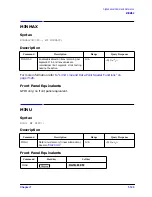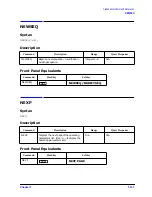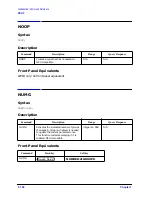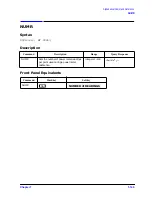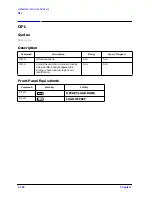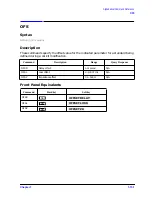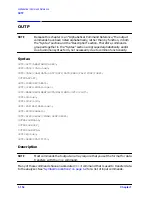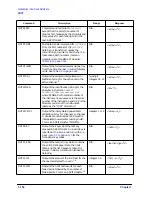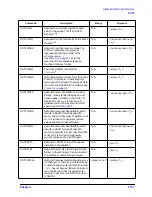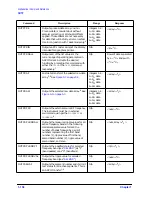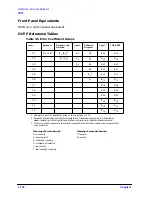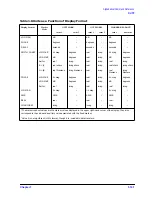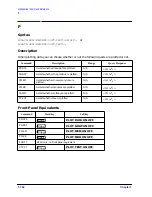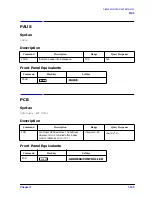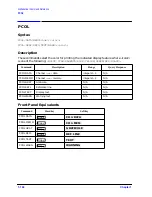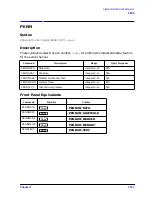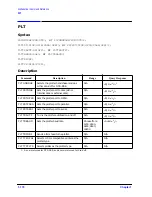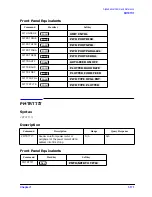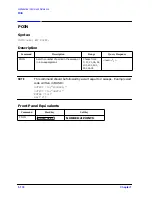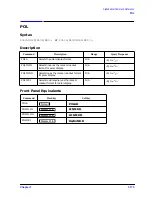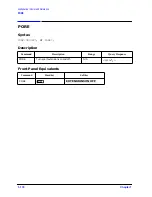
Chapter 1
1-159
Alphabetical Command Reference
OUTP
OUTPSEGAM
Outputs the limit test min/max for all
segments. Outputs the segment number,
max stimulus, max value, min stimulus,
min value for all active segments. This is
an ASCII transfer.
N/A
<array><
L
F
>
OUTPSEGF
Outputs the limit test status for a
specified segment. See also
1
,
N/A
<0|1|
−
1><
L
F
>
OUTPSEGM
Outputs limit test min/max for a specified
segment. See also
1
N/A
<num,num><
L
F
>
OUTPSEQ
Outputs the specified sequence listing to
the GPIB port.
integers 1–6
<$><
L
F
>
OUTPSERN
Outputs a string that contains the serial
number of the analyzer.
N/A
<$><
L
F
>
OUTPSTAT
Returns the status byte as an ASCII
integer (0–255) that can be interpreted as
the 8-bit status byte. Refer to
about the status byte. This command is
the same as
N/A
<num><
L
F
>
OUTPTITL
Outputs the display title in ASCII format.
N/A
<$><
L
F
>
1. Refer to
“Limit Line and Data Point Special Functions” on page 7-126
.
2. See
for the contents of the different arrays. Each array is output in the currently set form determined by
the
FORM
command. The data is in real/imaginary pairs, with the same number of pairs as points in the sweep.
3. This is one of four fast-data-transfer commands. These commands circumvent the internal “byte handler” routine
and output trace dumps as block data. In other words, the analyzer outputs the entire array without allowing any
process swapping to occur. FORM4 (ASCII) data transfer times are not affected by these routines. However, there
are speed improvements with binary data formats.
4. Values returned for limit test status are: 0 (fail), 1 (pass), or
−
1 (no limit).
5. This command outputs the limit test results. The results consist of four fields. First is the stimulus value for the
point. Second is an integer indicating test status. Third is the upper limit at that point. Fourth is the lower limit at
that point. If there are no limits at that point, the third and fourth fields are zero.
6. If there is not a currently active 2-port cal (full 2-port or TRL), this command will only output data for whichever
measurement is currently selected on the active channel, regardless of which number (<1|2|3|4>) is appended to
the command.
7. The I/O needs to be set to terminate upon two consecutive <
L
F
>s when using this command.
8. This command only applies to 8753ET/ES analyzers.
Command
Description
Range
Response
Summary of Contents for 8719ES
Page 15: ...1 1 1 Alphabetical Command Reference ...
Page 293: ...2 1 2 Introduction to Instrument Control ...
Page 310: ...3 1 3 GPIB Programming ...
Page 334: ...4 1 4 Reading Analyzer Data ...
Page 343: ...5 1 5 Data Processing Chain ...
Page 350: ...6 1 6 Error Reporting ...
Page 364: ...7 1 7 Programming Examples ...
Page 502: ...A 1 A Preset Conditions ...
Page 517: ...B 1 B Command Listings ...

